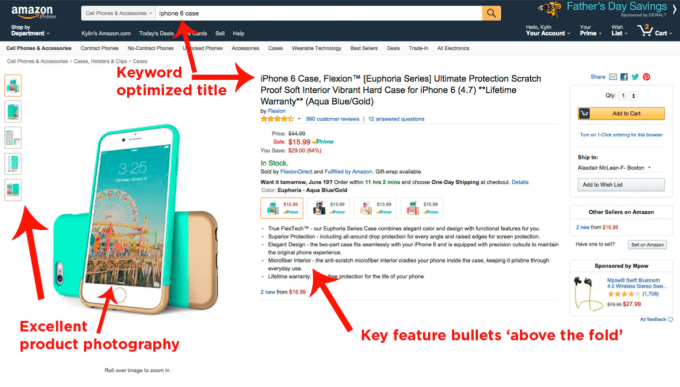In this post, we’re going to discuss what makes an Amazon listing “good,” which really means what makes an Amazon listing convert (i.e. convinces a shopper to add your product to their cart and check out). Spoiler alert: it really comes down to not a whole lot of things, so you really want to make sure that you get every single one of them right. When reading this post, you’re going to want to think about what you look for when you’re shopping on Amazon. Put on your buyer hat for a second, and think about when you’re looking at different product listings to buy for yourself, what do you usually focus on when making your decision to buy a particular product?
Let’s start with the most important factor (which is probably not a surprise): customer reviews (which are now called “ratings”). Amazon is a review based platform. When Amazon shoppers are not sure about a product they’ve never tried before, they will want to see what other people have said about it and what experiences they have had using it. That’s how the reviews typically work, which means that you need to make sure that your reviews are high so that potential customers know that they’re buying a good product.
In order to get good reviews, you need at least two things. The first is fairly obvious: a high quality product. If you’re selling a product that breaks, doesn’t do what it claims to do, or that doesn’t otherwise live up to your customers’ expectations, then you’re probably going to get bad reviews. These bad reviews are going to bring down your overall review rating, and shoppers are not going to buy your product (or even consider it). The second important factor in acquiring good reviews and maintaining a high overall review rating is regular and effective communication with your customers. If customers have a problem with your product, some of them are going to reach out to you and send you a message in order to voice their concern. If you are not responding to these kinds of messages or not providing high quality customer service, you’re probably going to get a lot of those complaints translating into bad reviews. On the other hand, if you are regularly communicating with your customers and responding to their complaints by sending them replacements for defective products, they’re going to be less likely to express their frustration in the form of a bad review.
After reviews/ratings, the second most important part of the listing that’s going to make it convert well is the product images. Amazon is an eCommerce platform, which means that customers can’t physically touch the products before making a decision to buy them. Instead, they will “inspect” the products they are browsing through by analyzing the images.
Here are a few simple rules for Amazon product images: 1) make sure that you’re using all available image positions 2), make sure that you’re using high quality images that are “zoomable” (optimal resolution is 1500 X 1000), and 3) make sure you have lifestyle images that show people or models using your product. Lifestyle images make the online shopping experience as real as possible for shoppers.
In addition to product images, the product title is an effective way to communicate with shoppers what your product is, and a strong title is a must have. The biggest mistake we see with titles is that they are either too short or too long. The really short titles usually don’t accurately convey to the customer what the product actually is (or contain enough keywords), and the really long titles tend to be confusing (and are usually a result of keyword stuffing). The fast and easy rule for product titles is to make sure that the they accurately express to the customer what the product actually is and what it does (using a few targeted keywords, of course). You don’t want to leave any unanswered question about the product you’re selling. Try to be as descriptive as possible while also being as succinct as possible.
You should also be taking advantage of Enhanced Brand Content (a.k.a. A+ Content) if you’re enrolled in brand registry. Enhanced brand content increases conversion rates for listings significantly by giving you the opportunity to talk about your brand and tell customers why they should support it. When a customer buys a product, they’re not only buying a product, they’re supporting a brand. So, if you’re brand registered, make sure you use that extra real estate towards the bottom of your listing to showcase your brand and tell why customers should support it (for example, do you support any causes or charities?).
The final element of a strong listing that is primed for conversion is having effective bullet points. Similar to the title, the bullet points should be used to target keywords and convey what the product actually is. You also don’t want to make them too short or too long. Like strong titles, effective bullet points will include concise descriptions of the product. Unlike titles, however, bullet points should only focus on benefits and features of the product (think of bullet points as extensions of the title). If a customer is taking the time to read the bullet points, chances are they have a high level of interest in your product, have spent a relatively long amount of time on your listings, and just need a little nudge to add your product to their cart. Accordingly, sellers who ignore or do not put much effort into the bullet points section of their products listings do themselves a great disservices and probably lose out on a significant number of sales.


Trackbacks/Pingbacks